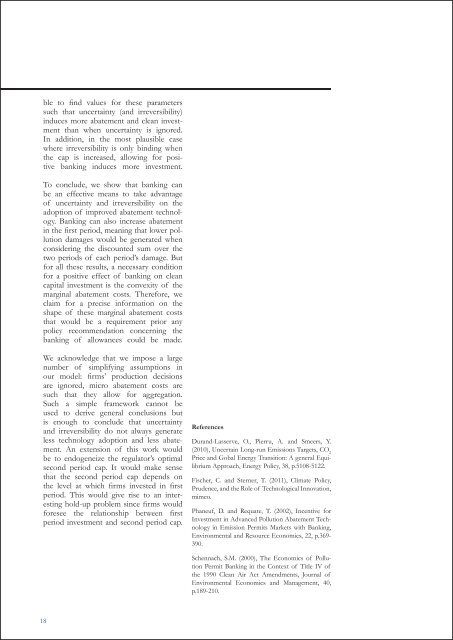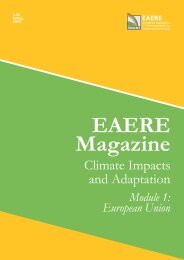EAERE Magazine - n.7 Fall 2019
Create successful ePaper yourself
Turn your PDF publications into a flip-book with our unique Google optimized e-Paper software.
le to find values for these parameters<br />
such that uncertainty (and irreversibility)<br />
induces more abatement and clean investment<br />
than when uncertainty is ignored.<br />
In addition, in the most plausible case<br />
where irreversibility is only binding when<br />
the cap is increased, allowing for positive<br />
banking induces more investment.<br />
To conclude, we show that banking can<br />
be an effective means to take advantage<br />
of uncertainty and irreversibility on the<br />
adoption of improved abatement technology.<br />
Banking can also increase abatement<br />
in the first period, meaning that lower pollution<br />
damages would be generated when<br />
considering the discounted sum over the<br />
two periods of each period’s damage. But<br />
for all these results, a necessary condition<br />
for a positive effect of banking on clean<br />
capital investment is the convexity of the<br />
marginal abatement costs. Therefore, we<br />
claim for a precise information on the<br />
shape of these marginal abatement costs<br />
that would be a requirement prior any<br />
policy recommendation concerning the<br />
banking of allowances could be made.<br />
We acknowledge that we impose a large<br />
number of simplifying assumptions in<br />
our model: firms’ production decisions<br />
are ignored, micro abatement costs are<br />
such that they allow for aggregation.<br />
Such a simple framework cannot be<br />
used to derive general conclusions but<br />
is enough to conclude that uncertainty<br />
and irreversibility do not always generate<br />
less technology adoption and less abatement.<br />
An extension of this work would<br />
be to endogeneize the regulator’s optimal<br />
second period cap. It would make sense<br />
that the second period cap depends on<br />
the level at which firms invested in first<br />
period. This would give rise to an interesting<br />
hold-up problem since firms would<br />
foresee the relationship between first<br />
period investment and second period cap.<br />
References<br />
Durand-Lasserve, O., Pierru, A. and Smeers, Y.<br />
(2010), Uncertain Long-run Emissions Targets, CO 2<br />
Price and Gobal Energy Transition: A general Equilibrium<br />
Approach, Energy Policy, 38, p.5108-5122.<br />
Fischer, C. and Sterner, T. (2011), Climate Policy,<br />
Prudence, and the Role of Technological Innovation,<br />
mimeo.<br />
Phaneuf, D. and Requate, T. (2002), Incentive for<br />
Investment in Advanced Pollution Abatement Technology<br />
in Emission Permits Markets with Banking,<br />
Environmental and Resource Economics, 22, p.369-<br />
390.<br />
Schennach, S.M. (2000), The Economics of Pollution<br />
Permit Banking in the Context of Title IV of<br />
the 1990 Clean Air Act Amendments, Journal of<br />
Environmental Economics and Management, 40,<br />
p.189-210.<br />
18













